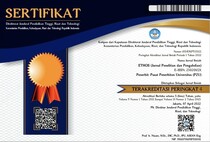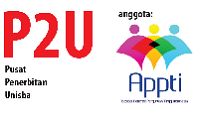Effect Of Gypsum (CaSO4) On Soil Using California Bearing Ratio Test
Abstract
Clay soil is a type of soil that has characteristics, namely low carrying capacity and large swelling and shrinkage, this makes clay soil a poor material for construction work. Civil building construction subgrade shear strength and California Bearing ratio (CBR) value influence the planning of a building. CBR is a comparison between the test load and the Standard Load and is expressed as a percentage. The CBR value was developed to measure the bearing capacity, soil load. The soil stabilization process includes mixing with gypsum material (C2SO4) to obtain the desired gradation so that soil properties become better with calcium levels which bind organic matter soil to clay and also absorb more water which is very useful for strengthening the soil. Testing the California Bearing Ratio (CBR) and direct shear strength of the soil (Direct Shear Test) by adding a different percentage of Gypsum (CaSO4) occurs in the addition of 6% Gypsum in 56 collisions with a value of 48%, in collisions 10 and 25 times the CBR value Optimum occurs in the percentage of 7% gypsum with a value of 27.48% and 28.5%, and the effect of adding gypsum on the cohesion value and the optimum internal friction angle occurs in the addition of 6% lime with a value of 0.017 MPa and 24.93o.
Keywords
Full Text:
PDFReferences
Anonim, 1981. Rock Characterization, Testing, and Monitoring. Ed. E. T. Brown, Oxford: ISRM, International Society for RockMechanics.
Das, B., Endah, N. & Indrasurya, 1988. Mekanika Tanah (Prinsip–prinsip Rekayasa Geoteknis). 1st ed. Jakarta: Erlangga.
Haras, M., E., T. A. & Legrans, R. R., 2017. Pengaruh Penambahan Kapur Terhadap Kuat Geser Tanah Lempung. TEKNO Vol.15/No.67, p. 79.
Hatmoko, J. T. & Lulie, Y., 2007. UCS Tanah Lempung Ekspansif yang Distabilisasi dengan Abu Ampas Tebu dan Kapur. Teknik Sipil, VIII(1), pp. 64-77.
Kapantouw Gloria, Sjachrul Balamba, Alva N. Sarajar. 2018. Korelasi Antara Tegangan Geser Dan Nilai CBR Pada Tanah Lempung Dengan Bahan Campuran Tras
Muhyi, A. A., Roesyanto, Hasibuan, G. C., Pengaruh Penambahan Bubuk Gypsum Terhadap Kuat Geser Tanah Berdasarkan Pengujian Triaksial Serta Pemodelan Dengan Metode Eleman Hingga. Jurnal Syntax Admiration Vol 3 No. 9 Hal. 1102 - 1114
Ingles & Metcalf, 1972. Soil Stabilization Second-Ed.
ISRM (1981): Rock Characterization Testing and Monitoring ISRM Suggested Method. E.T. Brown (Ed). Pergamon Press. 5 – 30.
Iswandaru, Isniarno, N. F., Hirnawan, R. F., Optimization and slope stability coal mine with dewatering system using limit equilibrium method. IOP Conference Series: Materials Science and Engineering, Vol 830, Issue 4, DOI 10.1088/1757-899X/830/4/042044
Nasrani, F. L., 2020. Analisis Geoteknik Tanah Lempung Terhadap Penambahan Limbah Gypsum. Jurnal Sipil Statik Vol. 8 No. 2 Hal. 197-204
Rahmaneta, S. 2020. Pengaruh Stabilisasi Kapur Terhadap Parameter Kuat Geser Tanah Lempung Ekspansif. Jurnal of The Civil Engineering Student Vol. 2 No. 1 Hal 8-14
Soedarmo, D. & Purnomo, E., 1993. Mekanika Tanah. Malang: Kanisius.
Suardi, E., 2005. Kajian Kuat Tekan Bebas Tanah Lempung yang Distabilisasi Dengan Aditive Semen dan Kapur. Jurnal Ilmiah Poli Rekayasa, I(1).
Wibawa, A., & Hisyam, E. (2015). Pengaruh Penambahan Limbah Gypsum Terhadap Nilai Kuat Geser Tanah Lempung. Fropil (Forum Profesional Teknik Sipil), 3(2), 65-71. https://doi.org/10.33019/fropil.v3i2.12
Wyllie, D. C. & Mah, C. W., 2004. Rock Slope Engineering Civil and mining. 4th ed. New York: Spon Press.
DOI: https://doi.org/10.29313/ethos.v11i1.10180
Refbacks
- There are currently no refbacks.
Alamat Redaksi:
LPPM Unisba, Lantai 2, Jl. Purnawarman 63, Bandung 40116, Jawa Barat, (022) 4203368 , (022) 4264064. ethos.unisba@gmail.com / ethos@unisba.ac.id

This work is licensed under a Creative Commons Attribution-NonCommercial-ShareAlike 4.0 International License.















